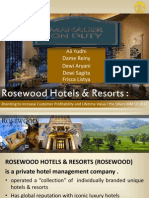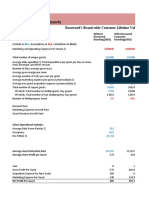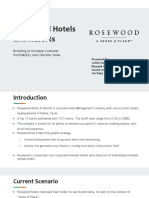Rosewood
Rosewood
Uploaded by
kyleplattnerCopyright:
Available Formats
Rosewood
Rosewood
Uploaded by
kyleplattnerOriginal Description:
Copyright
Available Formats
Share this document
Did you find this document useful?
Is this content inappropriate?
Copyright:
Available Formats
Rosewood
Rosewood
Uploaded by
kyleplattnerCopyright:
Available Formats
Rosewood Hotel Case Analysis----Branding Strategy Han Zhao MBA 671 Q1: Briefly define the following Individual
l Brand Strategy, Corporate Brand Strategy, and Customer Lifetime Value. Explain the strategic value of these concepts. Individual Brand Strategy Individual brand strategy is the marketing strategy of giving each product in a portfolio its own unique brand name. In this type of branding strategy, each product has its own unique brand image and identity which can cause advantages. It differentiates from different levels of customers needs. Individual brands can be classified by target markets with different location, culture, history, and so on. This facilitates the positioning of each product, by allowing a firm to position its brands differently and to distinguish its products. Comparing to a corporate branding, individual branding prominently focus on a firms product image instead of the firm itself. This can be a key to marketing that a firms different products do not interact with each other. Each product can create a trademark which may have a chance to be developed to an intangible asset. Like the relationship between Philip Morris and Marlboro, the best way of reducing negative impacts of Philip Morris from smoking bans is that not showing up in Marlboros advertisements. Corporate Brand Strategy Corporate branding is the practice of using a company's name as a product brand name. Like when someone says Hershey, you think of chocolates. With a corporate strategy, a corporate image can be thought of as the associations in the consumers memory to the company making the product or service as a whole. It facilitates new product acceptance because potential buyers are already familiar with the name. Corporate branding can result in significant economies of scope since one advertising campaign can be used for several products. As with individual brands, a corporate brand may evoke a strong association with consumers to a product attribute, which may cause product-related attributes and benefits. However, this strategy may hinder the creation of distinct brand images or identities for different products that an overarching corporate brand reduces the ability to position a brand with an individual identity, and may conceal different products' unique characteristics. Corporate brand strategy usually requires a high quality standard that contains innovative features. It is an attempt to use corporate brand equity to create product brand recognition. Customer Lifetime Value Customer lifetime value in marketing is the net present value of the cash flows that you will realize on the average customer during a given number of years. The use of customer lifetime value as a marketing metric tends to place greater emphasis on customer service and long-term customer satisfaction, rather than on maximizing short-term sales. Generally, CLV is typically used to identify profitable customers and to develop strategies to target customers. In the Rosewood Case, the CLV presents how much money Rosewood can invest to retain an existing customer.
Q2: Why is Rosewood considering a new brand strategy? Rosewood is considering a new brand strategy, because the individual branding strategy is not responding their objectives any more. For nearly 25 years Rosewood had built a global reputation for its ability to enhance a propertys value by creating a unique experience, with a small ultra-luxury style that differentiated it from other chain-like luxury competitors. However, guests are not making the connection between individual properties and others Rosewood Hotels & Resorts properties. Rosewood brand was muted, not very well known but it was not clear what is the best corporate branding strategy without destroying the value of each individually branded hotel and losing a customer. Competing with other hotel properties, the Rosewood has only 5% of cross-selling rates, which is not only one of the lowest in the industry of individual branded hotels (5%-10%) but also compare with corporate branded hotels. (10%-15%). If Rosewood aims to remain competitive, they will have to grow. The individual strategy limits Rosewood only a subset of the luxury market with saying that those sophisticated customers who value the distinctive, exclusive collection hotel. Whereas research suggested that the vast majority customers within the luxury hotel market valued the corporate-branded hotel. Therefore the current brand positioning substantially limits Rosewoods market. Hence, a new branding strategy proposing an increased customer profitability and lifetime value is needed. Q3: With respect to the Rosewood situation, what are the pros and cons of moving from an individual brand strategy to a corporate brand strategy?
Pros Increasing brand recognition Increasing sales Increasing cross-selling rate and multiproperty return visit rate
Cons Additional marketing investment Loss of the sense of lace and one-of-akind. Alienating certain existing guests.
To move into a corporate brand strategy, it helps increase guests awareness and knowledge about the Rosewood brand name. With the improvement of being recognized by customers, the number of other properties visited by one guest will grow. A known corporate brand name will encourage hotel guests to stay at some of other Rosewood hotels. Rosewoods new president and CEO, John Scott is considering a new strategy to boost the companys growth. To generate a growth is the initial purpose of Rosewood, but a current individual brand strategy only provide 5% cross-selling rate. Comparatively, a corporate brand strategy will increase the number of guests visits and retained guests which directly affects Rosewoods sales revenues that matches the goal of a profit company. Not only will increase in the sales, a corporate branding builds up the companys image. Corporate branding can result in significant economies of scope since one advertising campaign can be used for several products. It also facilitates new product acceptance because potential buyers are already familiar with the name. Rosewood wants to compete with the corporate and individual branded luxury hotels. As individual branded company, is hard to compete with the corporate brands which benefit from cross-property usage.
While there are numerous benefits of moving to a corporate branding, strategy may hinder the creation of distinct brand images or identities for different products. A corporate strategy could unintentionally devalue the uniqueness of each hotel if the corporate brand overpowers current individuality. Rosewoods new branding may lose the identity of a unique, one-of-a-kind, experience that is highly differentiated from other corporate companies. To keep the brand promised, corporate brand strategy requires brand based performance consistency across portfolio. It will be hard to ensure that each hotel that Rosewood owns keeps reflecting the local culture. As time goes by, Rosewood will face a change of overall companys culture. Also, Incorporating as Rosewood properties may alienate some existing investor relationships such as those who reside at the Carlyle in New York, whove already shown reluctance to the new branding strategy. Moreover, a marketing and operational investment of 1 million per year will be spent to implement the corporate branding identity. The CEO has to make sure if the profit made by the change will cover the extra cost or not. Q4: With respect to the Rosewood situation, discuss the impact of corporate branding on customer lifetime value. (See Appendix attached) Ultimately, Scott the CEO of Rosewood needs to convince the company that greater Customer Lifetime Value will outweigh the marketing and operational expenditure associated with promoting a new branding.
Looking at the anticipated number of making a change to corporate branding, the number of repeat guests will grow up from 19,169 to 24,919, and the number of multi-property stay guests will increase from 5,750 to 11,500 which is about to double. The retention rate also rises up from 16.67% to 21.67% with the new strategic change.
However, there is an average increase of $8.70 per guest due to new marketing expense which offsets the gross profit. Although extra spending will be made by change, the expected cash flow from customer is still higher than the cash flow without change. By calculating the net present value of customer lifetime value with and without implementing corporate strategy, it can be found that in 6 years, the total NPV of CLTV with change exceed the total NPV of CLTV without change of an amount of $8,909,750. As we know, if NPV is positive the acquisition, the spending is a wise investment. The more the amount exceeds the more profitable outcome it will be. Then we conclude that with corporate branding, Rosewood will gain $8,909,750 more than staying the individual branding. The corporate brand strategy will positively affects Rosewoods revenue and will also lead to a higher level of brand recognition. Despite the revenue benefit, the company should also realize that the anticipated number of guest visits, retention rate, discount rate and growth rate may adjust due to many reasons, like economic depression. This is to say, there are many risks of making such a big change of branding strategy.
Q5: Assuming the individual hotel managers are against the corporate brand strategy initiative, how would you gain their commitment to the change should it be made? In the case, managers feel threatened in their autonomy to manage the properties, so they are more inclined to promote just their own individual hotel brands, particularly if they have a strong brand. By gain their commitment to accept new strategy change, there are two main things have to be considered. To be straight forward, money and rights are benefits expected by managers. I would like to show them the analysis of CLTV which interprets that promoting new strategy generates greater revenues. This calculation will be a compelling financial argument to convince managers. The companys marketing department should provide a future plan about the implementation of corporate brand strategy. The CEOs commitment to managers and employees is also very important. Rosewood has to face a big problem of rebuilding an emotional connection with all Rosewood properties. It also needs to create a healthy and energetic atmosphere of the company. In this case, individual managers will not feel to be threatened, and they may turn to be actively support the new strategy. Instead of moving directly to the new branding strategy, I would recommend to merge the Rosewood brand with its properties identities smoothly by a long-term programming. This is a necessary concern for those managers or resistances who have a pertinacious and conservative bigotry against the new strategy. It also helps to keep each propertys existing clients. By adding a Rosewood brand name before each propertys name, like the Hilton Garden Inn, Rosewood can think of an opposite way by adding Rosewood after a propertys name, like The Mansion on Turtle Creek, Rosewood. Thus, Rosewood will achieve the goals of keeping properties identities and increasing Rosewood brand awareness, while using a corporate brand. For those existing guests, they will still choose to stay in The Mansion on Turtle Creek, and now they know the hotel is under a Rosewood brand name. In a word, the CEO and his marketing team have to convert a long-term benefit from new strategy to an immediate benefit that can be grasped by individual managers.
You might also like
- Rosewood Case SpreadsheetDocument2 pagesRosewood Case Spreadsheetjbuckley7485% (20)
- Rosewood Hotels and Resorts - CLV Data Taken From Exhibit ADocument2 pagesRosewood Hotels and Resorts - CLV Data Taken From Exhibit ASanchit GangarNo ratings yet
- Rosewood Hotel Case StudyDocument22 pagesRosewood Hotel Case StudySagita Simanjuntak88% (16)
- Rosewood Hotel & Resorts: Rosewood's Brand-Wide Customer Lifetime Value Spreadsheet ModelDocument4 pagesRosewood Hotel & Resorts: Rosewood's Brand-Wide Customer Lifetime Value Spreadsheet ModelPaolo ZanoniNo ratings yet
- Roosewood CaseDocument1 pageRoosewood CaseBrian Roosenberg0% (3)
- Accra Beach - Case SolutionDocument6 pagesAccra Beach - Case SolutionAhmed Sifat Naveel67% (3)
- Invoice TemplateDocument1 pageInvoice TemplateUrpi Samara CNo ratings yet
- Rosewood Hotels and Resorts CaseDocument5 pagesRosewood Hotels and Resorts Casemkojok112211100% (2)
- Mountain Man Brewing Company Analysis UpdatedDocument8 pagesMountain Man Brewing Company Analysis UpdatedSandhya Rajan50% (2)
- ISACA 2023 Invoice PDFDocument6 pagesISACA 2023 Invoice PDFSatish Kumar Reddy ByreddyNo ratings yet
- Rosewood Hotel CaseDocument5 pagesRosewood Hotel Casenpsr22100% (2)
- RosewoodDocument5 pagesRosewoodAnyone SomeoneNo ratings yet
- Rosewood Hotels and Resorts - Case AnalysisDocument18 pagesRosewood Hotels and Resorts - Case AnalysisAlex Fernandes100% (3)
- Financial Data For Rosewood Hotel and ResortsDocument3 pagesFinancial Data For Rosewood Hotel and ResortsSheldone Pillai100% (2)
- Rosewood CLTV SpreadsheetDocument6 pagesRosewood CLTV SpreadsheetRavi ThakurNo ratings yet
- CRM Rosewood Hotels and Resorts CaseDocument4 pagesCRM Rosewood Hotels and Resorts CaseBhargav Stopkony PandyaNo ratings yet
- Rosewood Threats WeaknessesDocument1 pageRosewood Threats WeaknessesScottFeltsNo ratings yet
- Rosewood Hotels & Resorts: Customer Lifetime Value (CLTV) Analysis InputsDocument8 pagesRosewood Hotels & Resorts: Customer Lifetime Value (CLTV) Analysis InputsSeemab AhmadNo ratings yet
- Rosewood Case SpreadsheetDocument6 pagesRosewood Case SpreadsheetShiva Krishna PadhiNo ratings yet
- Rosewood Hotels & Resorts: Customer Lifetime Value (CLTV) Analysis InputsDocument10 pagesRosewood Hotels & Resorts: Customer Lifetime Value (CLTV) Analysis InputsDost MuhammadNo ratings yet
- Alligiant Airlines AssignmentDocument13 pagesAlligiant Airlines AssignmentImran MalickNo ratings yet
- LL. Bean CaseDocument2 pagesLL. Bean CaseJason zhuNo ratings yet
- Rosewood CaseDocument7 pagesRosewood CaseSwetha VasuNo ratings yet
- Rosewood HotelsDocument2 pagesRosewood Hotelspanamajacks100% (2)
- MKT Rosewood Case AnalysisDocument4 pagesMKT Rosewood Case AnalysisLinda Prince50% (2)
- RosewoodDocument2 pagesRosewoodEricka Ayala100% (1)
- Rosewood HotelsDocument6 pagesRosewood Hotelssegement_valuesNo ratings yet
- RosewoodDocument6 pagesRosewoodAnindya Basu100% (1)
- Rosewood Case - Group 5 Section BDocument4 pagesRosewood Case - Group 5 Section BAyush YadavNo ratings yet
- Rosewood Case AnalysisDocument5 pagesRosewood Case AnalysisJayant KushwahaNo ratings yet
- Rosewood Case AnalysisDocument4 pagesRosewood Case AnalysisAbhijeet SinghNo ratings yet
- Rosewood Hotel & Resorts: Rosewood's Brand-Wide Customer Lifetime Value Spreadsheet ModelDocument4 pagesRosewood Hotel & Resorts: Rosewood's Brand-Wide Customer Lifetime Value Spreadsheet ModelKathGuNo ratings yet
- Rosewood Hotels and Resorts AnalysisDocument9 pagesRosewood Hotels and Resorts AnalysisdariusNo ratings yet
- Rosewood Hotels Case Study - MM v2Document7 pagesRosewood Hotels Case Study - MM v2Nemish KuvadiaNo ratings yet
- Rosewood CaseDocument7 pagesRosewood CaseAniket PatniNo ratings yet
- Rosewood !22,86,121,94Document9 pagesRosewood !22,86,121,94Vishakha NaraNo ratings yet
- RosewoodDocument12 pagesRosewoodAmbuj SinghNo ratings yet
- Rosewood Hotels and ResortsDocument5 pagesRosewood Hotels and Resortskhushi kumari100% (1)
- Particulars With Individual Branding With Rosewood Corporate BrandingDocument4 pagesParticulars With Individual Branding With Rosewood Corporate BrandingSiddharth LunkadNo ratings yet
- RosewoodDocument4 pagesRosewoodShruti VinyasNo ratings yet
- Dokumen - Tips - Rosewood Hotels Resorts Branding To Increase Customer Profitability andDocument36 pagesDokumen - Tips - Rosewood Hotels Resorts Branding To Increase Customer Profitability andPaolo Zanoni100% (1)
- Case Study Presentation By: Rosewood Hotels & ResortsDocument16 pagesCase Study Presentation By: Rosewood Hotels & Resortssaurabhpathak390% (3)
- Rosewood - CVLDocument7 pagesRosewood - CVLMichelle HuaNo ratings yet
- Rosewood's Brand-Wide CLTV Calculation: 5,750 11500 16.67% 21.67% Average Guest Retention RateDocument4 pagesRosewood's Brand-Wide CLTV Calculation: 5,750 11500 16.67% 21.67% Average Guest Retention RateGunjan ShahNo ratings yet
- Raman Dhiman Indian Institute of Management (Iim), ShillongDocument19 pagesRaman Dhiman Indian Institute of Management (Iim), ShillongShruti VinyasNo ratings yet
- Rosewood Hotel Case Study - 160831200335Document28 pagesRosewood Hotel Case Study - 160831200335Shailesh Soni100% (1)
- Rosewood Hotels and Resorts: Branding To Increase Customer Profitability and Lifetime ValueDocument26 pagesRosewood Hotels and Resorts: Branding To Increase Customer Profitability and Lifetime ValueAshishNo ratings yet
- Mountain Men Brewing CompanyDocument12 pagesMountain Men Brewing CompanyStephanie Lawrence Knop25% (4)
- Rosewood Hotels Resorts CLTV Sensitivity Analysis GRP 4Document24 pagesRosewood Hotels Resorts CLTV Sensitivity Analysis GRP 4t3ddyme123No ratings yet
- Hilton Hhonors WorldwideDocument35 pagesHilton Hhonors Worldwidevivekchaubey67% (3)
- Mountain Man Brewing CompanyDocument1 pageMountain Man Brewing Companynarender sNo ratings yet
- CLV Calculation With No Changes To Brand Strategy: NPV of Expected Cash Flow From Customer (CLV) $378.49Document4 pagesCLV Calculation With No Changes To Brand Strategy: NPV of Expected Cash Flow From Customer (CLV) $378.49killerboyeNo ratings yet
- Hilton Hotel Case AnalysisDocument2 pagesHilton Hotel Case AnalysisDeepikaNo ratings yet
- Frankenmuth CaseDocument8 pagesFrankenmuth CaseSudhanshu N RanjanNo ratings yet
- Case Study Presentation By: Rosewood Hotels & ResortsDocument15 pagesCase Study Presentation By: Rosewood Hotels & Resortssaurabhpathak39No ratings yet
- Mountain Man Brewing Scenario AnalyzerDocument4 pagesMountain Man Brewing Scenario AnalyzerAnjulHans100% (1)
- HiltonDocument14 pagesHiltonBhargav PancholiNo ratings yet
- Mountain Man Brewing CompanyDocument6 pagesMountain Man Brewing CompanyChida_m100% (3)
- LilypadDocument19 pagesLilypadvibhor_khandelwal_1No ratings yet
- BM FinalDocument20 pagesBM FinalmpimcaNo ratings yet
- Marketing During A Recession: 6 Strategies To Maximize Your Marketing BudgetDocument10 pagesMarketing During A Recession: 6 Strategies To Maximize Your Marketing Budgetabdullah.bo50.comNo ratings yet
- Brand Positioning Refers To "Target Consumer's" Reason To Buy Your Brand in Preference To Others. It IsDocument11 pagesBrand Positioning Refers To "Target Consumer's" Reason To Buy Your Brand in Preference To Others. It IsAndrew BrownNo ratings yet
- Chapter 3 - Spring's Entrepreneur's Blueprint (E285 - S24)Document11 pagesChapter 3 - Spring's Entrepreneur's Blueprint (E285 - S24)carbajal.alexNo ratings yet
- HSBC - Global LNG - On The Cusp of A New Boom (2019 02 14)Document44 pagesHSBC - Global LNG - On The Cusp of A New Boom (2019 02 14)Andre d'AlvaNo ratings yet
- CA Foundation Maths LR Stats Q MTP 2 Dec 2022Document16 pagesCA Foundation Maths LR Stats Q MTP 2 Dec 2022anandrs421No ratings yet
- Eeb SummaryDocument7 pagesEeb SummaryRohan KabraNo ratings yet
- FABM Fundamentals of ABM1Document157 pagesFABM Fundamentals of ABM1Yoxi Zerun100% (1)
- Trabajo de Campo Global Week 3Document11 pagesTrabajo de Campo Global Week 3Geraldine Carhuas GeronimoNo ratings yet
- Wallstreetjournal 20230422 TheWallStreetJournal PDFDocument57 pagesWallstreetjournal 20230422 TheWallStreetJournal PDFRazvan Catalin CostinNo ratings yet
- DRAFT DOCS SU - KOTA JATI - 1X40stdDocument10 pagesDRAFT DOCS SU - KOTA JATI - 1X40stdNomor PaketNo ratings yet
- Micro and Small Scale Industries Project Class 12Document29 pagesMicro and Small Scale Industries Project Class 12rajesh12911kumarNo ratings yet
- Chapter #4Document9 pagesChapter #4Kedir GeletuNo ratings yet
- Saddam ShaikhDocument1 pageSaddam ShaikhSaddam ShaikhNo ratings yet
- Adobe Scan 1 May 2024Document17 pagesAdobe Scan 1 May 2024solanki.prabhuNo ratings yet
- FOREX MindsetDocument50 pagesFOREX MindsetPallavi100% (2)
- Case Study On Spain S TelefonicaDocument2 pagesCase Study On Spain S Telefonicaoggyo8492No ratings yet
- General Stages and Relevant Processes of Listing With DSE Through IPODocument5 pagesGeneral Stages and Relevant Processes of Listing With DSE Through IPOJustin Louis D CostaNo ratings yet
- Subsale (Part 1)Document25 pagesSubsale (Part 1)Alisya TajularifinNo ratings yet
- DraftDocument12 pagesDraftJenelle macasaquitNo ratings yet
- Unit-1 Banking and Insurance ManagementDocument25 pagesUnit-1 Banking and Insurance ManagementChandra sekhar VallepuNo ratings yet
- BE 4023 Tutorial 1Document7 pagesBE 4023 Tutorial 1MC SquiddyNo ratings yet
- May 24 Last Day Important Revision QuestionsDocument20 pagesMay 24 Last Day Important Revision QuestionsShivam GagnejaNo ratings yet
- AIFGUDSEP2024Document73 pagesAIFGUDSEP2024dharmesh80yahooNo ratings yet
- Quiz On Cost Accounting and Control - Ch. 1-3-1Document3 pagesQuiz On Cost Accounting and Control - Ch. 1-3-1Elmarie Versaga DesuyoNo ratings yet
- 2024 FRL StockDocument7 pages2024 FRL Stockswhaider.32411007No ratings yet
- May 2020Document140 pagesMay 2020ARGHA PAULNo ratings yet
- India Sectoral - Credit - Deployment - For - March - 2024Document7 pagesIndia Sectoral - Credit - Deployment - For - March - 2024purveshparekhNo ratings yet
- ProcurementDocument18 pagesProcurementfeteneNo ratings yet
- Failure Mode Effect Analysis Process Capability Enhancement A Case Study IJERTV2IS4793Document10 pagesFailure Mode Effect Analysis Process Capability Enhancement A Case Study IJERTV2IS4793mn1938No ratings yet
- Merger Acquisition MCQ NTU PDFDocument7 pagesMerger Acquisition MCQ NTU PDFTrinh Nguyễn Ngọc PhươngNo ratings yet

























































































